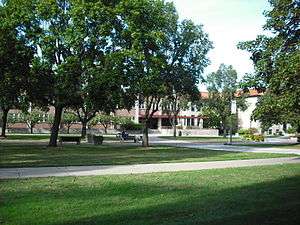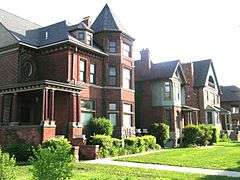University District, Detroit

Website is http://www.udca.info
University District is a neighborhood in Detroit, Michigan, United States. Located one mile west of Woodward Avenue, the University District is named for its neighbor to the south, the University of Detroit Mercy (UDM).[1] The neighborhood is bounded on the north by residential Seven Mile Road, on the south by McNichols Road and the UDM campus, and on the east by the Detroit Golf Club and Golf Club Estates. The western boundary is Livernois Avenue: once known to Detroiters as “the Avenue of Fashion,” this commercial boulevard of small shops is becoming “Gallery Row,” home to a growing collection of art galleries and art-related businesses.
Architecture
The University District's 1,200 single family homes were built mainly during the “golden age of housing” from 1925-1930 and 1937-1941, when construction technology was highly developed, building costs were low, and old world craftsmen were in plentiful supply. The homes reflect a wide variety of styles: English Tudor, Romanesque, Italianate, Spanish Mission, French Provincial, Queen Anne, Georgian, Federalist, Art Moderne, and contemporary. The predominant Tudor style, consistent setbacks, rear-of-lot garages, and mature shade trees provide a coherent design aesthetic that gives the University District its distinctive visual identity. Interior features include intricate plasterwork, leaded or stained glass windows, oak paneled libraries, hand-pegged hardwood floors, one or more fireplaces, Pewabic Pottery tile, and crystal chandeliers. Most homes offer four to six bedrooms, a minimum of three bathrooms, two-car garages, and a fully finished basement that includes a furnace room, laundry room, fitness room and a large family room with wet bar and fireplace. Many of these family rooms have now been converted to home theaters.
The District also includes two small apartment buildings and 80 duplex homes, many of which are occupied by University faculty and graduate students.
Detroit's only Frank Lloyd Wright home, the Dorothy H. Turkel House, sits just outside the District on Seven Mile Road.
Amenities and cultural resources
Amenities in the University District include the Belden Tot Lot and Gesu Community Green and Garden. Nearby are the running track at UDM, Northwest Activities Center, the venerable Detroit Golf Club, and Palmer Park's playing fields, tennis courts, and public golf course. Cultural resources include the UDM Theatre Company in performance at Marygrove College, the Detroit Repertory Theater, and world-renowned Baker's Keyboard Lounge, as well as Sherwood Forest, Lincoln and Parkman Branch Libraries.
Community organization
The University District Community Association consists of 15 elected Board members.[2] UDCA functions include publishing a quarterly newsletter, maintaining a website, sponsoring a volunteer radio patrol and walking tours of the neighborhood, planning social events, snowplowing non-emergency streets, and organizing support for neighborhood schools, community-wide yard sales, and biennial Home and Garden Tours.
Surrounding communities include the Golf Club Estates, Palmer Woods, Green Acres, Sherwood Forest, Bagley Community, and Martin Park. All are part of the 12th Precinct Coalition and University Commons, umbrella organizations that address issues of area-wide interest.
The University District is a Detroit Neighborhood Enterprise Zone (NEZ), entitling home buyers to reduced property taxes for up to 15 years.
History
The area now called the University District was originally farmland in the survey township of Greenfield, Michigan, organized by its residents in 1833 and named for its prosperous farms. A typical title abstract in the neighborhood shows a first sale by the "United States of America, Martin Van Buren, President," on April 1, 1837. The University District was annexed to the City of Detroit in the election of November 7, 1916. In November 1920, John P. McNichols, S.J., the newly appointed president of the University of Detroit, traveled with armed companions from the campus on Jefferson Avenue in downtown Detroit to Six Mile Road (then known as Palmer Boulevard, now called McNichols Road). He carried a satchel supposedly containing $120,000 in cash (it contained sliced newspaper—the cash was in his overcoat) to purchase the farm that is now the Main Campus of the University of Detroit Mercy. Four months later, 33 building lots along Livernois north of Palmer were sold in a three-day period. Gesu Catholic Church was soon established despite proximity to the Seven Mile and Livernois area. For several decades, the southwest quadrant of the University District was home to large Catholic families, including that of Detroit Mayor Jerome Cavanagh.
In the 1920s and 1930s, the first homeowners were primarily realtors, senior partners in law firms and insurance agencies, or the owners and managers of prosperous Detroit businesses. Notable residents have included business owners such as Stanley Winkleman of the Detroit department store chain bearing his name, and musicians from the Detroit Symphony Orchestra. Concertmaster Mischa Mischakoff entertained visiting conductors and soloists at his University District home: subsequent owners have preserved the foyer wall autographed by these artists. African-American families began moving into the University District in the 1960s, depicted on stage in Palmer Park, a play by Joanna Glass, who lived in the neighborhood during that time.
Education
University District is within the Detroit Public Schools district. Residents are zoned to Barbara Jordan Elementary School/Hampton Middle School for K-8,[3] while residents are zoned to Mumford High School for high school.[4]
See also
Notes
- ↑ University of Detroit Mercy retrieved 27 April 2015
- ↑ University District Community Association retrieved 18 Feb 2016
- ↑ "Jordan/Hampton MS Attendance Area." Detroit Public Schools. Retrieved on March 30, 2009.
- ↑ "Mumford HS Attendance Area." Detroit Public Schools. Retrieved on March 30, 2009.
References
- Burton Abstract and Title Company, Abstract of Title, Lot 654, Golf Club Addition
- Burton, Clarence Monroe (1930) History of Wayne County and the city of Detroit Michigan, The S. J. Clarke Publishing Company
- Howe, Jeffery (ed.) (2002) The houses we live in: an identification guide to the history and style of American domestic architecture, Thunder Bay Press, San Diego
- McAlester, Virginia and Lee (2006) A field guide to American houses, Alfred A. Knopf, New York
- Muller, Herman J. (1976) The University of Detroit 1877-1977: a centennial history, University of Detroit
External links
- University of Detroit Mercy
- University District Community Association
- Palmer Park by Joanna Glass
- The Turkel House by Frank Lloyd Wright
- Woodward Avenue
Coordinates: 42°25′26″N 83°08′13″W / 42.424°N 83.137°W

